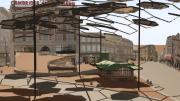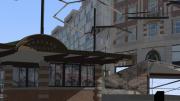“There have been many watershed moments in the history of Harvard Square,” says Caroline James, M.Arch ’14. “Right now, with so many spaces in play, is absolutely one of those moments,” says James, one of the leading voices in the debate about what will happen to the Square.
The Dow and Stearns Family Trust’s recent decision to sell its holdings on Brattle Street, along with a number of business closures, have contributed to an increasingly complex conversation about the Square’s future. One focal point of that conversation has been the controversy over the historic Out of Town News kiosk, the iconic newsstand outside the MBTA Red Line station. The city of Cambridge commissioned the Galante Architecture Studio to do a major redesign of the building, and the resulting proposal replaced the brick exterior with LED lighting and screens, turning the building into a tourist information booth. Those plans were rejected following community backlash in March, though the fate of the kiosk and the plaza surrounding it still hangs in the balance.
Our Harvard Square (OHSQ), an organization that bills itself as a “group of stakeholders working towards design excellent for Harvard Square and ensuring an open, diverse and equitable design process,” has paid special attention to the fate of Out of Town News. Partially due to its efforts to rally public support for the kiosk’s preservation (and reject Galante's proposal), the Cambridge Historical Commission (CHC) voted unanimously to recommend that the city designate the building as a historical landmark, promoting the building from its current spot on the National Register of Historic Places.
To increase community engagement with the plaza's redesign process, OHSQ has been sourcing design proposals from within the community by holding idea incubators. These sessions are open to architects, planners, Cambridge residents, and anyone else with an interest in contributing an afternoon to reimagining this public space. “We need to trust the intuition of the people who actually use the plaza space and involve them in the process,” says Michael Haggerty, MUP ’06, M.Arch ’17. “It is urban, it is full of users and activity. We need to ask, ‘What are the people who are using the Square doing, and what would they like to see?’”
One likely controversial proposal includes closing Harvard Square to traffic to better accommodate pedestrians and bring more foot traffic to local businesses, while another suggests turning the plaza into a space with more seating. On November 4, the Harvard Square Neighborhood Association (HSNA, of which Our Harvard Square is a part) plans to share these design proposals with the city in preparation for a November 6 meeting to evaluate submissions.
Suzanne Blier, Clowes chair of fine arts and of African and African American Studies, and a founder of the HSNA, was part of a meeting earlier in October with Regency Centers Corporation, the real estate investment trust that is leading the “Collection at Harvard Square” project, a pedestrian mall that would affect the flatiron-style wedge of buildings on the corner of J.F.K and Brattle Street, namely the Brattle, Abbott, and Corcoran Buildings. In a whitepaper Blier shared with Harvard Magazine after the meeting, the HSNA underscores that it remains “extremely concerned about the long-term survival of Harvard Square’s unique brand and diverse retail ecosystem, which is increasingly threatened by the concentration of property ownership, rising rents, and related displacement by national retailers that diminish the Square as a unique destination.”
Blier says Regency was surprisingly amenable to the HSNA’s suggestions. Regency accepted HSNA’s request that the Abbott Building remain a distinct structure in the rooftop terrace construction that would affect the three adjacent buildings. The real estate firm also shared plans to reintroduce basement retail spaces underneath the Abbott Building earmarked for “affordable retail and public occupancy.” In the meantime, Gerald Chan’s proposed renovation of unused theater space on Church Street is still progressing.
“This ultimately needs to be a conversation about the goals of Harvard Square,” said Cambridge City councilwoman Jan Devereux about the Square’s redesign process during a recent GSD panel about the redesign process. “We need to continue to show them [the city] that we care about what happens to this iconic space. We’re watching.”








